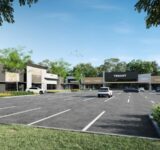 By Michael J. Wachter, PE, LEED AP BD+C, Executive Vice President, and Zachary Zeiders, PE, Senior Electrical Engineer
By Michael J. Wachter, PE, LEED AP BD+C, Executive Vice President, and Zachary Zeiders, PE, Senior Electrical Engineer
The phrase ‘Carbon Neutral’ is the latest climate-based trend we are seeing amongst some of the world’s largest companies, including Amazon, FedEx, Ford and many others. Becoming carbon neutral is the process of a building, or company, achieving net-zero carbon dioxide emissions. Carbon neutrality is achieved by reducing carbon emissions or a combination of offsetting emissions where they would be generated elsewhere.
With e-commerce sales at record highs, the need for more warehouse space has increased. When we design new warehouses and upgrade existing customer assets, we often receive questions from building owners on how they can design buildings for the future, incorporating their future tenants’ carbon neutral practices, such as last mile delivery services with plans to electrify their corporate fleets.
While every building design is undoubtedly unique, the mechanical, electrical and plumbing systems we utilize across our designs remain consistent so that we are able to provide our clients with reliable and low maintenance systems for their facilities. In a typical carbon neutral facility, we start by eliminating the gas service to the building in its entirety and electrifying all systems. From there, we provide tenants with adequate charging systems for all their fleet vehicles. Finally, we work with solar providers to install roof panels to offset electric absorbed from the grid during off hours and high demand periods.
The following examples offer a look into how we would incorporate these design practices into a typical 100,000-square-foot dry goods warehouse and can further be expanded upon for conditioned and larger facilities.
Our HVAC team typically utilizes high CFM, direct gas-fired, 100% outside air, rooftop mounted units to heat the facilities in our standard designs. The design typically provides, on average, one unit per 25,000 square feet of space. These units can be provided with electric coils or duct heaters, to shift the energy source from gas to electric. The electric heating elements for a similar BTU output range between 250-350kW in the Mid-Atlantic region but would fluctuate depending on the specific design criteria and the outdoor air requirements of the space. While the increase in electrical capacity of these units is substantial, the need for gas piping and a carbon monoxide detection system is eliminated, typically resulting in offsetting system costs.
In this example, we anticipate the average annual electric energy consumption of these units to be around 125,000kWh each, or 500,000kWh total, for the 100,000-square-foot building over a one-year period. The electric energy unit costs are higher than natural gas energy unit costs in the Mid-Atlantic, which results in higher cost of electric heating for the warehouse over standard gas fired units. However, the electric energy usage can be completely offset during the day by a properly sized solar array discussed in the next section.
Many tenants anticipate expanding their electric vehicle fleets over the next 10 years. The electric fleets for tenants range from standard passenger vehicles to last mile delivery vehicles, and ultimately full-size tractor trailers. The biggest bottleneck in utilizing electric vehicle has been charging time. Battery sizes for typical passenger vehicles are around 75kWh, increasing to around 200kWh for a last mile delivery van, and topping off at 500 to 1,000kWh for a tractor trailer. When exploring chargers there are many factors to consider, including usage and charging time.
Standard commercial chargers range from a 7.2kW to 20kW level 2 chargers, to 250kW-400kW level 3 ‘DC Fast Chargers’. Level 2 chargers have the capability to charge a passenger vehicle and a last mile delivery vehicle in about 10 hours, and a tractor trailer in about 25 hours. Level 3 chargers have to the capability to charge a passenger vehicle in about 30 to 45 minutes, and a tractor trailer in about 2 hours.
Similar to electrifying the heating system of the building, the electrical capacity required for these electric vehicles can seem daunting when comparing that (10) ten Level 3 chargers. These can easily take up the available capacity of a single 2,500kVA utility transformer. Thankfully, charging technology in the last few years has allowed these chargers to communicate with each other, allowing the designer to assume a lesser demand on the system to increase the number of chargers without putting the electrical demand on the building electrical infrastructure. For example, it would be possible to allocate 750kW for the vehicle charging system, serving twenty (20) level 2 chargers and (4) four Level 3 chargers, the smart charging infrastructure would then distribute power accordingly.
A simple example of potential yearly energy consumption from for the example warehouse, assuming 5 passenger vehicles (75kWh), 20 last mile vans (180kWh), and 5 tractor trailers (500kWh), with 50% daily recharge rate, would consume roughly 1,000,000kWh over the course of a year.
The final piece of the puzzle and the main offset of consumed energy for the facility is ensuring an adequately sized solar array. The latest solar panel technology is producing solar panels with wattages nearing 400 per panel. For our general warehouse example, assuming a 70% rooftop coverage, and 18 square feet per panel, we can install approximately 3,850 panels on the rooftop. If the panel output is 300W and you obtain an average of 5 hours of sunlight per day, a conservative estimate of yearly power production would exceed 2,100,000kWh.
As noted in our calculations for heating and electric vehicle usages, the rooftop solar will generate more power than needed, even when including basic assumptions for lighting and general power. The solar in this case will offset the total electrical usage of all building systems and electric vehicles for the case presented creating a complete carbon neutral facility. To further tenant and developer carbon neutral initiatives, the excess power can offset carbon emissions generated elsewhere the tenant or developer’s real estate portfolio.
It is our hope as designers of these facilities to work towards Carbon Neutral and zero emissions, and over time the utility providers are working towards cleaning up utility power for a greener future. We understand going full electric is a daunting task for many aspects of the building, and that the majority of utility power is still generated from fossil fuels. With the help of installing solar panels, we can help drive the electric costs down and work towards net zero electrical consumption of the facilities. With a few small steps during the design of these facilities tenants and developers can offset power in their facilities, push green power back onto the grid, and eliminate the need for gas or fossil fuels in their company’s operation.
(732) 438-1600
20 South Middlesex Avenue
Suite B
Monroe Township, NJ 08831
————————
Pennsylvania
(267) 519-3439
8 Penn Center
1628 John F Kennedy Boulevard,
Suite 1200
Philadelphia, PA 19103
————————
New York
(347) 589-8822
116 Nassau Street, 5th Floor,
Suite 512
New York, NY 10038











